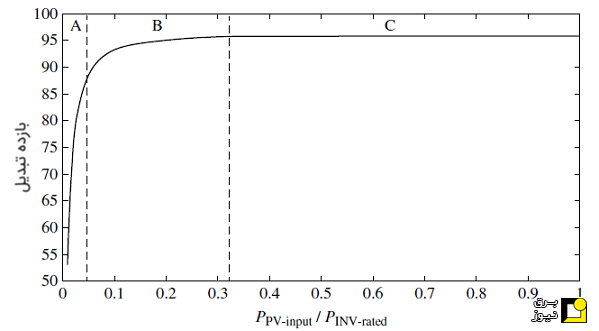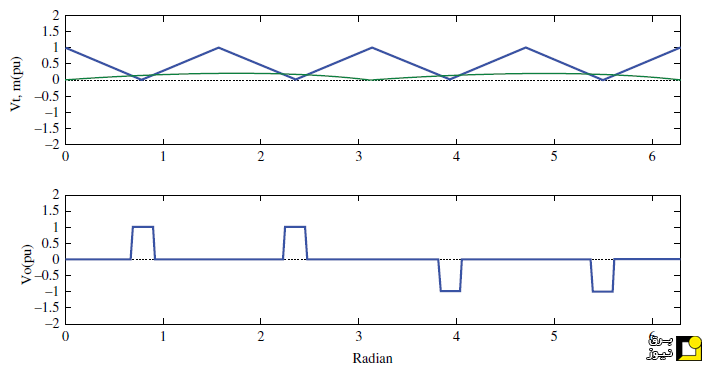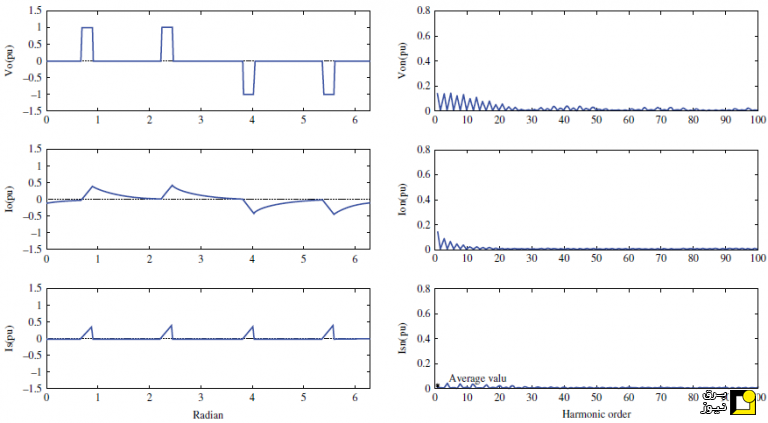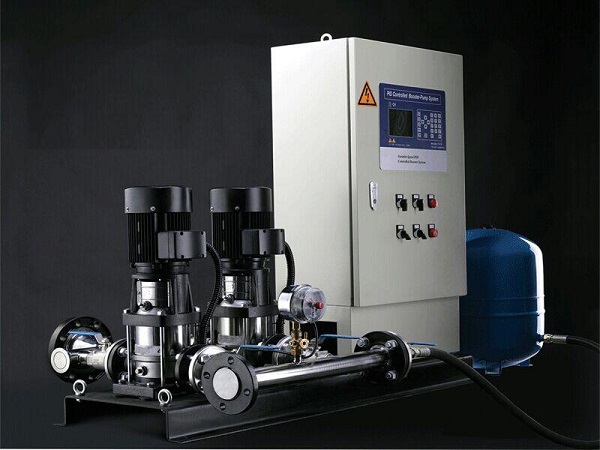چگونه اینورتر را در متلب شبیه سازی کنیم؟+کد
اینورتر یکی از انواع مبدلهای الکترونیک قدرت است که کاربرد زیادی در سیستمهای فتوولتائیک دارد. همانطور که میدانیم، برق تولیدی یک سلول خورشیدی، جریان مستقیم است و برای آنکه بتوانیم از آن برای دستگاهها و لوازم استفاده کنیم، باید یک اینورتر DC به AC را به کار بریم.
سرویس آموزش و آزمون برق نیوز، اینورتر یکی از انواع مبدلهای الکترونیک قدرت است که کاربرد زیادی در سیستمهای فتوولتائیک دارد. همانطور که میدانیم، برق تولیدی یک سلول خورشیدی، جریان مستقیم است و برای آنکه بتوانیم از آن برای دستگاهها و لوازم استفاده کنیم، باید یک اینورتر DC به AC را به کار بریم. در سیستمهای فتوولتائیک منفصل از شبکه، اینورتر سیگنال DC را به سیگنال AC تبدیل میکند. بنابراین، مدل آن باید با توجه به بازده تبدیلش انتخاب شود. در سیستمهای متصل به شبکه، اینورترها سیگنال خروجی را با توجه تغییر فرکانس و فاز، با شبکه سنکرون میکنند. در این آموزش، برنامه شبیه سازی اینورتر در متلب را ارائه خواهیم کرد.
شکل ۱ منحنی کارایی اینورتر تجاری را که از دیتاشیت آن به دست آمده نشان میدهد. این منحنی، بازده اینورتر را با توجه به توان ورودی و توان نامی آن بیان میکند.

شکل ۱: منحنی بهره یک اینورتر
منحنی بهرهوری را میتوان با تابع توانی زیر توصیف کرد:

که در آن، PPVو PINVC به ترتیب توان خروجی ماژول PV و توان نامی اینورتر و c۱، c۲ و c۳ضرایب مدل هستند. با ابزار برازش متلب میتوان ضرایب مدل اینورتر را محاسبه کرد. توجه کنید که مدل اینورتر متصل به شبکه کاملاً متفاوت است، زیرا به بررسی مشخصات سیگنال نیاز دارد.
برای مثال، میخواهیم برنامه متلب یک اینورتر PWM را با سیگنال خروجی ۵۰ هرتز، شاخص مدولاسیون ۲۰ درصد، فرکانس حامل ۲۰۰ هرتز و زاویه فاز بار ۲۵ درجه بنویسیم. این برنامه به صورت زیر است:
شکل ۱ منحنی کارایی اینورتر تجاری را که از دیتاشیت آن به دست آمده نشان میدهد. این منحنی، بازده اینورتر را با توجه به توان ورودی و توان نامی آن بیان میکند.

شکل ۱: منحنی بهره یک اینورتر
منحنی بهرهوری را میتوان با تابع توانی زیر توصیف کرد:

که در آن، PPVو PINVC به ترتیب توان خروجی ماژول PV و توان نامی اینورتر و c۱، c۲ و c۳ضرایب مدل هستند. با ابزار برازش متلب میتوان ضرایب مدل اینورتر را محاسبه کرد. توجه کنید که مدل اینورتر متصل به شبکه کاملاً متفاوت است، زیرا به بررسی مشخصات سیگنال نیاز دارد.
برای مثال، میخواهیم برنامه متلب یک اینورتر PWM را با سیگنال خروجی ۵۰ هرتز، شاخص مدولاسیون ۲۰ درصد، فرکانس حامل ۲۰۰ هرتز و زاویه فاز بار ۲۵ درجه بنویسیم. این برنامه به صورت زیر است:
اگر این برنامه را اجرا کنیم، از ما خواسته میشود که اطلاعات زیر را وارد کنیم. این اطلاعات را با توجه به اعداد مذکور بالا وارد میکنیم:
% A Program For Analysis of a Voltage-source inverter with Sinusoidal-Pulse-Width Modulated output.
% PART I (preparatihttps://blog.faradars.org/wp-admin/post.php?post=510349&action=edit#on)
% In this part the screen is cleared, any other functions, figures and
% variables are also cleared. The name of the program is displayed.
clc
clear all
disp('Voltage-source inverter with Sinusoidal-Pulse Width Modulated output')
disp(' By Tamer Khatib ')
disp('')
%
% PART II
% In this part the already known variables are entered, the user is
% asked to enter the other variables.
% Vrin is the DC input voltage.
Vrin=1;
% f is the frequency of the output voltage waveform.
f=input('The frequency of the output voltage, f = ');
% Z is the load impedance in per unit.
Z=1;
% ma is the modulation index
ma=input('the modulation index,ma, (0<ma<1), ma = ');
% phi is load-phase-angle
phi=input('the phase angle of the load in degrees = ');
% fc is frequency of the carrier signal.
fc=input('The frequency of the carrier signal= ');
%
% PART III
% Calculating load parameters.
%
phi=phi*pi/180;
% R and L are the load resistance and inductance respectively.
R=Z*cos(phi);
L=(Z*sin(phi))/(2*pi*f);
%
% PART IV
% Calculating the number of pulses per period,N
N=fc/f;
%
%PART V
% Building the Sawtooth signal,Vt, the output voltage waveform, Vout,
% and finding the beginning (alpha) and the end (beta)for each of the output pulses.
%
% In each period of the sawtooth, there is one increasing and decreasing part of
% the sawtooth, thus the period of the output voltage waveform is divided into
% 2N sub-periods, k is used as a counter of these sub-periods.
% for calculation purposes each of these sub-periods is divided into 50 points, i.e., the
% output voltage waveform period is divided into 100N points.
% j is a counter inside the sub-period
% i is the generalized time counter
for k=1:2*N
for j=1:50
% finding the generalized time counter
i=j+(k-1)*50;
% finding the time step
wt(i)=i*pi/(N*50);
%finding the half period of the output voltage.
if(sin(wt(i)))>0
hpf=1;
else
hpf=-1;
end
% calculating the modulating signal.
ma1(i)=ma*abs(sin(wt(i)));
% calculating the sawtooth waveform
if rem(k,2)==0
Vt(i)=0.02*j;
if abs(Vt(i)-ma*abs(sin(wt(i))))<=0.011
m=j;
beta(fix(k/2)+1)=3.6*((k-1)*50+m)/N;
else
j=j;
end
else
Vt(i)=1-0.02*j;
if abs(Vt(i)-ma*abs(sin(wt(i))))<0.011
l=j;
alpha(fix(k/2)+1)=3.6*((k-1)*50+l)/N;
else
j=j;
end
end
% calculating the output voltage waveform
if Vt(i)>ma*abs(sin(wt(i)))
Vout(i)=0;
else
Vout(i)=hpf*Vrin;
end
end
end
beta(1)=[];
% PART VI
% Displaying the beginning (alpha), the end (beta) and the width
% of each of the output voltage pulses.
disp(' ')
disp('......................................................................')
disp('alpha beta width')
[alpha' beta' (beta-alpha)']
% PART VII
% Plotting the , the triangular carrier signal, Vt,
% the modulating signal and the output voltage waveform, Vout.
a=0;
subplot(2,1,1)
plot(wt,Vt,wt,ma1,wt,a)
axis([0,2*pi,-2,2])
ylabel('Vt, m(pu)');
subplot(2,1,2)
plot(wt,Vout,wt,a)
axis([0,2*pi,-2,2])
ylabel('Vo(pu)');
xlabel('Radian');
% PART VIII
% Analyzing the output voltage waveform
% Finding the rms value of the output voltage
Vo =sqrt(1/(length(Vout))*sum(Vout.^2));
disp('The rms Value of the output Voltage = ')
Vo
% finding the harmonic contents of the output voltage waveform
y=fft(Vout);
y(1)=[];
x=abs(y);
x=(sqrt(2)/(length(Vout)))*x;
disp('The rms Value of the output voltage fundamental component = ')
x(1)
%
% Finding the THD of the output voltage
THDVo = sqrt(Vo^2 -x(1)^2)/x(1);
%
% PART IX
% calculating the output current waveform
m=R/(2*pi*f*L);
DT=pi/(N*50);
C(1)=-10;
%
i=100*N+1:2000*N;
Vout(i)=Vout(i-100*N*fix(i/(100*N))+1);
%
for i=2:2000*N;
C(i)=C(i-1)*exp(-m*DT)+Vout(i-1)/R*(1-exp(-m*DT));
end
% PART X
% Analyzing the output current waveform
% finding the harmonic contents of the output current waveform
for j4=1:100*N
CO(j4)=C(j4+1900*N);
CO2= fft(CO);
CO2(1)=[];
COX=abs(CO2);
COX=(sqrt(2)/(100*N))*COX;
end
% Finding the RMS value of the output current.
CORMS = sqrt(sum(CO.^2)/(length(CO)));
disp(' The RMS value of the load current =')
CORMS
%Finding the THD for the output current
THDIo = sqrt(CORMS^2-COX(1)^2)/COX(1);
% PART XI
% Finding the supply current waveform
for j2=1900*N+1:2000*N
if Vout(j2)~=0
CS(j2)=abs(C(j2));
else
CS(j2)=0;
end
end
% PART XII
% Analyzing the supply current waveform
%
% Supply current waveform and its average value
for j3=1:100*N
CS1(j3)=abs(CS(j3+1900*N));
end
CSRMS= sqrt(sum(CS1.^2)/(length(CS1)));
disp('The RMS value of the supply current is')
CSRMS
CSAV= (sum(CS1)/(length(CS1)));
disp('The Average value of the supply current is')
CSAV
% Finding the Fourier analysis of the supply current waveform
CS2= fft(CS1);
CS2(1)=[];
CSX=abs(CS2);
CSX=(sqrt(2)/(100*N))*CSX;
% PART XIII
% Displaying the calculated parameters.
disp(' Performance parameters are')
THDVo
THDIo
a=0;
%PART XIV
% Opening a new figure window for plotting of
% the output voltage, output current, supply current and the harmonic
% contents of these values
figure(2)
subplot(3,2,1)
plot(wt,Vout(1:100*N),wt,a);
title('');
axis([0,2*pi,-1.5,1.5]);
ylabel('Vo(pu)');
subplot(3,2,2)
plot(x(1:100))
title('');
axis([0,100,0,0.8]);
subplot(3,2,3)
plot(wt,C(1900*N+1:2000*N),wt,a);
title('');
axis([0,2*pi,-1.5,1.5]);
ylabel('Io(pu)');
subplot(3,2,4)
plot(COX(1:100))
title('');
axis([0,100,0,0.8]);
ylabel('Ion(pu)');
subplot(3,2,5)
plot(wt,CS(1900*N+1:2000*N),wt,a);
axis([0,2*pi,-1.5,1.5]);
ylabel('Is(pu)');
xlabel('Radian');
subplot(3,2,6)
plot(CSX(1:100))
hold
plot(CSAV,'*')
text(5,CSAV,'Average valu')
title('');
axis([0,100,0,0.8]);
ylabel('Isn(pu)');
xlabel('Harmonic Order');
در نتیجه، خروجی برنامه به صورت زیر خواهد بود:
Voltage-source inverter with Sinusoidal-Pulse Width Modulated output By Tamer Khatib The frequency of the output voltage, f = 50 the modulation index,ma, (0<ma<1), ma = 0.2 the phase angle of the load in degrees = 25 The frequency of the carrier signal= 200
در نتیجه خروجی برنامه به شکل زیر خواهد بود.
alpha beta width
ans =
39.6000 52.2000 12.6000
127.8000 140.4000 12.6000
219.6000 232.2000 12.6000
307.8000 320.4000 12.6000
The rms Value of the output Voltage =
Vo =
0.3742
The rms Value of the output voltage fundamental component =
ans =
0.1408
The RMS value of the load current =
CORMS =
0.1859
The RMS value of the supply current is
CSRMS =
0.0906
The Average value of the supply current is
CSAV =
0.0295
Performance parameters are
THDVo =
2.4618
THDIo =
0.8624
Current plot held
شکل ۲، ولتاژ خروجی پریونیت اینورتر را نشان میدهد.

شکل ۲: خروجی مدل اینورتر

شکل ۳ نیز ولتاژ و جریان را نشان میدهد.

شکل ۲: خروجی مدل اینورتر

شکل ۳ نیز ولتاژ و جریان را نشان میدهد.
انتشار یافته: ۱
در انتظار بررسی: ۰
غیر قابل انتشار: ۰
درود بر شما مطالبی عالی ورزنده بود با تشکر





از ارسال دیدگاه های نا مرتبط با متن خبر، تکرار نظر دیگران، توهین به سایر کاربران و ارسال متن های طولانی خودداری نمایید.
لطفا نظرات بدون بی احترامی، افترا و توهین به مسئولان، اقلیت ها، قومیت ها و ... باشد و به طور کلی مغایرتی با اصول اخلاقی و قوانین کشور نداشته باشد.
در غیر این صورت، «برق نیوز» مطلب مورد نظر را رد یا بنا به تشخیص خود با ممیزی منتشر خواهد کرد.